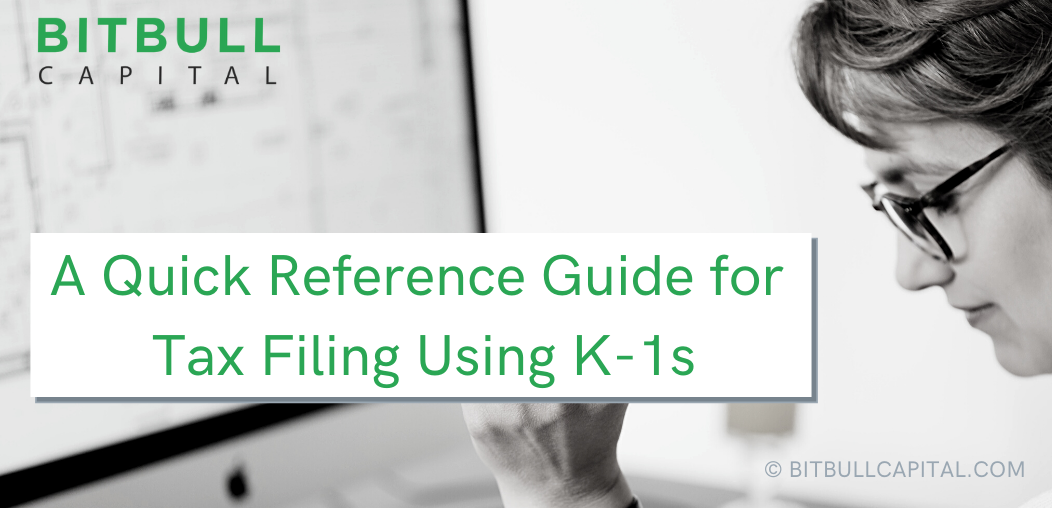BitBull Fund is pleased to offer its investors a K-1 every year issued by our administrator. We hope that in the reference guide for tax filing using K-1s, you will find your taxes simplified.
Additionally, if you’ve ever invested in a business that uses one of several different types of legal structures, such as partnership, “C” corporation, or LLC, or if you’re the beneficiary of a trust or an estate, then you’ve probably received a Schedule K-1 in the mail during tax season.
Let’s take a closer look at the Schedule K-1 form, the implications for you, and what you must do with it.
What is Schedule K-1?
Schedule K-1 is a schedule of IRS Form 1065 that members of a business partnership use to report their share of a partnership’s profits, losses, deductions and credits to the IRS.
Where can I find a sample tax K-1 form?
You can download a sample copy of Schedule K-1 (Form 1065) from the [https://www.irs.gov/pub/irs-pdf/f1065sk1.pdf).
In our case you’ll receive a copy of Schedule K-1 around tax time from our administrator, Richey May & Co. (nationally ranked top 20 hedge fund auditors).
Remember that the IRS won’t accept your personal tax return (Form 1040) if it doesn’t have a Schedule K-1 attached.
Purpose of Schedule K-1?
The purpose of Schedule K-1 is to report each participant’s share of the business entity’s gains, losses, deductions, credits, and other distributions (whether or not they’re actually distributed). While not filed with an individual partner’s tax return, the financial information posted to each partner’s Schedule K-1 is sent to the IRS with Form 1065. Income generated from partnerships is added to the partner’s other sources of income and entered on Form 1040.
Types of Scheduled K-1 Form
The type of Schedule K-1 form you fill out depends on the business type. The business or estate files the appropriate form, and then the individual fills out the corresponding Schedule K-1.
| Form | Who Uses It |
| 1065 | Partnerships |
| 1120-S | S corporations |
| 1041 | Beneficiaries of trusts and estates |
Schedule K-1 (Form 1065)
Form 1065 is the most common Schedule K-1 form and is used by partners in a partnership. This includes general partnerships, limited partnerships, LLPs, and LLCs.
Schedule K-1(Form 1120-S)
Shareholders of an S corporation use form 1120-S.
Schedule K-1 (Form 1041)
People who are beneficiaries of an estate or trust use form 1041[i]
Who has to File Schedule K-1?
Similar to a W2 or 1099 form, a Schedule K-1 lists taxable income, but it’s only for particular types of business entities. The form shows the income that you’ve received from the business and breaks it into different categories.
How to Fill Out and Read a Schedule K-1
Outside of a business’s income or losses, a Schedule K-1 will include sections to record dividends, capital gains, rental real estate income, deductions, and credits, so have that information handy before beginning.
If you’re involved in a partnership, you will need to include the employer identification number, what type of partner you are, your share of profit and losses at the beginning and end of the tax year, and your share of liabilities at the beginning and end of the tax year. If you have any deductions or credits, you will enter those into boxes 12, 13, and 15. The form also includes sections to record the following:
Foreign transactions
Alternative minimum tax items
Tax-exempt income and non-deductible expenses
Distributions (money paid to partners or members during the year)
If you’re a shareholder of an S corporation, you won’t need to include information about your share of profit or losses; you will only need to note what percentage of stock you owned for the tax year. Do so in box F.
Can a Schedule K-1 be E-Filed?
A Schedule K-1 can be filed electronically with your personal tax return.
How to complete the Schedule K-1?
Schedule K-1 filing instructions depend on the identity of the tax filer. There are three different Schedule K-1 forms:
- Form 1041 Schedule K-1 for the beneficiaries of a trust or estate
- Form 1065 Schedule K-1 for partnerships
- Form 1120S Schedule K-1 for S-corps
Although each form K-1 contains slightly different information, these are the common elements in each Schedule K-1:
- Information about the company, trust, or estate (Part I)
- Information about the business owner or beneficiary (Part II)
- Information about the partner’s or beneficiary’s share of the current year income, losses, deductions, and credits (Part III)
The reason that income, losses, and other items are broken down by category is that different types of taxable income are subject to different tax rates. For example, the individual income tax rate is different from the capital gains tax rate. The information for parts I to III should all be available from your business tax return or your business’s financial statements. The partnership agreement, LLC operating agreement, and corporate bylaws should also contain information about each owner’s share of the business.
Schedule K-1 FAQs
The Schedule K-1 tax form is an important business tax form that our LPs receive each year.
Will I receive one even if with losses?
You should expect a Schedule K-1 every year you are a partner or shareholder in a business organized as a pass-through entity. This applies even if the business has operated at a loss for the year.
Is IRS Schedule K-1 Income Considered Earned Income?
It varies, depending on the individual’s participation and status. For trust and estate beneficiaries, limited partners, and passive investors, Schedule K-1 income is more akin to unearned income.
When will I receive my K-1 from BitBull Fund?
September is our estimate, but that is due to timing of our underlying K-1s, which is out of our control.
For additional investor related tax questions see our previous blog, “Common Crypto Tax Related Questions Answered.”
[i] https://www.thebalancesmb.com/how-is-schedule-k-1-filed-397512

